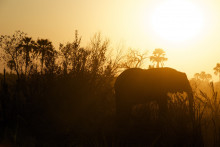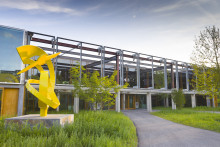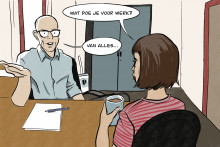‘It is one minute to midnight for Africa as we know it,’ says the professor of Earth Structure and Dynamics. ‘The continent appears to be splitting up along a fault line that runs straight through Botswana. That means that a piece of Africa will ultimately break away and drift off, exactly like South America did at one time.’
It sounds shocking, but Van der Meijde can put the current generation of earthlings at ease. ‘We are talking about a timeline of hundreds of thousands of years. If the age of the planet itself is like a day, that period is like a minute.’
The second most severe earthquake
The fact that the ITC researchers even made this discovery is a stroke of luck. The NWO-funded project was supposed to be over already. However, Van der Meijde and his colleagues applied for an extension and their patience was rewarded. On the 3rd of April, 2017 – two months after the project was scheduled to end and the equipment was supposed to be shipped back to Enschede – the second most severe earthquake in Botswana’s history (6.5 on the Richter Scale, with no fatal casualties) took place.
The project involved a lot of work, Van der Meijde explains. His office is decorated with a map of Botswana with twenty-one pins in it. These mark the exact locations where the researchers, together with Botswana’s geological service and Utrecht University, placed seismometers. It took them a year and a half to put all the equipment in the right place.
‘A piece of Africa will ultimately break away and drift off’
Van der Meijde visited Botswana frequently during the project. He helped with the installation of the equipment and with finding suitable locations. ‘If you leave something in the wilderness unguarded, it will be gone within 48 hours,’ the professor says. ‘People are motivated as much by bad intentions as by mere curiosity. All told, every station houses a lot of valuable equipment: a seismometer worth around fifteen thousand euros and another thousand euros’ worth of batteries, a solar panel, a GPS modem, and a mobile transmitter.’
Tribal chiefs and lions
The search for safe places to install the sensitive equipment was an adventure in its own right. The researchers did everything from asking tribal chiefs for permission to sleeping in camps that were a bit too popular among the local lion population. ‘We first looked at the locations of telecommunication transmitter masts,’ Van der Meijde explains. ‘Those are fairly well protected, because of the risk of theft and vandalism. The best sites turned out to be primary schools. They are located in large, fenced-off areas. By involving the schools, we could have them share in the responsibility.’

Next, it took the team a few days to install the equipment. At sites with a lot of loose soil, the Botswana geological service dug holes, placed empty water tanks inside, and filled the bottom with cement. The equipment was then placed on top. Above ground, they built small roofs to protect the equipment from the elements, as well as a solar panel on a post. In locations where the soil was firmer, they built small shacks to protect the equipment.
Hide and seek
All this effort paid off in the end. The European Space Agency’s GOCE satellite picked up a signal in the border region where Angola, Zambia and Botswana meet. The ITC researchers suspected that the entire East-African fault line was located 500 kilometres further south. Van der Meijde: ‘We encountered plenty of scepticism when we explained this at conferences. ‘Where is your seismic activity,’ our colleagues would ask us. We never abandoned our theory, however. The area we were looking at is practically uninhabited. There are just a few nomadic tribes who travel across it. Small tremors are hard to feel when you are sleeping in a tent. Our patience was rewarded in the end. It was like this enormous earthquake was playing a deft game of hide and seek and we suddenly managed to catch it in the act.’
The ITC scientists will hand over the equipment and the responsibility for the project to the Botswana geological service in 2018. The project is almost over for ITC. The papers written about the team’s findings are pending review by prominent journals. Van der Meijde himself is now studying seismic activity on – or rather, under – the Italian island of Sardinia. ‘I am using far more advanced seismometers than what we installed in Botswana at the time,’ he says excitedly. ‘They are eight times more energy-efficient. Compared to the old equipment, the installation process is a breeze. That alone creates so many new opportunities.’

The researcher is gathering a wealth of new data, every small bit of which is enough to write a paper about, Van der Meijde claims. Ultimately, his goal in Sardinia is the same as before: getting to the bottom of it. So we can learn more about the subterranean world beneath our feet.
You can also find this article in the latest edition of our Science & Technology Magazine. Grab a copy at the campus or see the magazine online.








